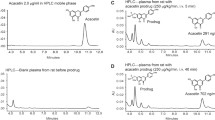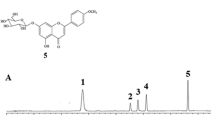Abstract
Caffeic acid derivatives constitute a class of potent anti-inflammatory and cardioprotective drug candidates. We recently synthesized a new caffeic acid derivative N-propyl caffeamide (PCA). Our pilot experiments demonstrated that PCA enhanced the survival of rat cardiomyocyte H9c2 cells against oxygen glucose deprivation and reoxygenation challenge in a concentration-dependent manner. Interestingly, PCA exhibited better cardioprotective potential than caffeic acid phenethyl ester and propyl caffeate. Thus, we hypothesized that PCA could protect heart against ischemia reperfusion (I/R) injury in mice. We first determined the stability and pharmacokinetic profile of PCA in male Sprague–Dawley rats by ultra-performance liquid chromatography coupled with UV and MS/MS detections. The stability of PCA in rat plasma was defined by the half-life of 31.39, 7.19 and 1.37 h in rat plasma at 25, 37 and 60 °C, respectively. To study the pharmacokinetic profiles, PCA was injected into male SD rats at the dose of 15 mg/kg via intravenous bolus administration. PCA showed the elimination half-life of approximate 235 min in rats. We subsequently evaluated the cardioprotective potential of PCA in mice model of myocardial infarction. Our results demonstrated that PCA effectively reduced infarct size and release of myocardial enzymes (e.g., CK, CK-MB and LDH). Biochemical analyses suggested that PCA increased the activities of antioxidant enzymes (e.g., CAT and SOD) while attenuated lipid peroxidation. Moreover, PCA profoundly reduced the number of apoptotic cells in infarcted myocardium. Consistently, PCA increased the expression level of anti-apoptotic protein Bcl2 whereas suppressed the expression of pro-apoptotic protein Bax in cardiac tissues. Collectively, PCA appears to be a novel bioavailable and stable pharmacological treatment for myocardial infarction.





Similar content being viewed by others
Abbreviations
- AAR:
-
Area at risk
- BOP:
-
Benzo-triazol-1-yloxy-tris(dimethylamino)phosphonium hexafluorophosphate
- BSA:
-
Bovine serum albumin
- CAPE:
-
Caffeic acid phenethyl ester
- CAT:
-
Catalase
- CK:
-
Creatine kinase
- CK-MB:
-
Myocardial muscle creatine kinase
- DMEM:
-
Dulbecco’s modified Eagle’s medium
- DMSO:
-
Dimethyl sulfoxide
- ECL:
-
Enhanced chemiluminescence
- ESI-MS:
-
Slectrospray ionization-mass spectrometry
- GAPDH:
-
Glyceraldehydes-3-phosphate dehydrogenase
- HRP:
-
Horseradish peroxidase
- IgG:
-
Immunoglobulin G
- LC/MS/MS:
-
Liquid chromatography/mass spectrometry/mass spectrometry
- LAD:
-
Left anterior descending coronary artery
- LDH:
-
Lactate dehydrogenase
- MPO:
-
Myeloperoxidase
- OGD:
-
Oxygen glucose deprivation
- PCA:
-
N-Propyl caffeate amide
- ROS:
-
Reactive oxygen species
- RNS:
-
Reactive nitrogen species
- SOD:
-
Superoxide dismutase
- TTC:
-
Triphenyltetrazolium chloride
References
Bonow RO, Smaha LA, Smith SC Jr et al (2002) World heart day 2002: the international burden of cardiovascular disease: responding to the emerging global epidemic. Circulation 106:1602–1605
Borgeat P, Naccache PH (1990) Biosynthesis and biological activity of leukotriene B4. Clin Biochem 23:459–468
Buja LM, Vela D, Silva GV et al (2007) Pathological assessment of stem cell therapy for myocardial ischernic disease. J Mol Cell Cardiol 42:S95
Chen YR, Zweier JL (2014) Cardiac mitochondria and reactive oxygen species generation. Circ Res 114:524–537
Cheng YY, Xia ZY, Han YF et al (2016) Plant natural product formononetin protects rat cardiomyocyte H9c2 cells against oxygen glucose deprivation and reoxygenation via inhibiting ROS formation and promoting GSK-3β phosphorylation. Oxid Med Cell Longev 2016:2060874
Cook SA, Sugden PH, Clerk A (1999) Regulation of bcl-2 family proteins during development and in response to oxidative stress in cardiac myocytes: association with changes in mitochondrial membrane potential. Circ Res 85:940–949
da Cunha FM, Duma D, Assreuy J et al (2004) Caffeic acid derivatives: in vitro and in vivo anti-inflammatory properties. Free Radic Res 38:1241–1253
Del Rio D, Stewart AJ, Pellegrini N (2005) A review of recent studies on malondialdehyde as toxic molecule and biological marker of oxidative stress. Nutr Metab Cardiovasc Dis 15:316–328
Dong JW, Zhu HF, Zhu WZ et al (2003) Intermittent hypoxia attenuates ischemia/reperfusion induced apoptosis in cardiac myocytes via regulating Bcl-2/Bax expression. Cell Res 13:385–391
Fiuza SM, Gomes C, Teixeira LJ et al (2004) Phenolic acid derivatives with potential anticancer properties—a structure-activity relationship study. Part 1: methyl, propyl and octyl esters of caffeic and gallic acids. Bioorg Med Chem 12:3581–3589
Goldmann BU, Rudolph V, Rudolph TK et al (2009) Neutrophil activation precedes myocardial injury in patients with acute myocardial infarction. Free Radic Biol Med 47:79–83
Hakonarson H, Thorvaldsson S, Helgadottir A et al (2005) Effects of a 5-lipoxygenase-activating protein inhibitor on biomarkers associated with risk of myocardial infarction: a randomized trial. JAMA 293:2245–2256
Helgadottir A, Manolescu A, Helgason A et al (2006) A variant of the gene encoding leukotriene A4 hydrolase confers ethnicity-specific risk of myocardial infarction. Nat Genet 38:68–74
Ho YJ, Lee AS, Chen WP et al (2014) Caffeic acid phenethyl amide ameliorates ischemia/reperfusion injury and cardiac dysfunction in streptozotocin-induced diabetic rats. Cardiovasc Diabetol 13:98
Hori M, Nishida K (2009) Oxidative stress and left ventricular remodelling after myocardial infarction. Cardiovasc Res 81:457–464
Jolly SR, Kane WJ, Hook BG et al (1986) Reduction of myocardial infarct size by neutrophil depletion: effect of duration of occlusion. Am Heart J 112:682–690
Jordan JE, Zhao ZQ, Vinten-Johansen J (1999) The role of neutrophils in myocardial ischemia–reperfusion injury. Cardiovasc Res 43:860–878
Kart A, Cigremis Y, Ozen H et al (2009) Caffeic acid phenethyl ester prevents ovary ischemia/reperfusion injury in rabbits. Food Chem Toxicol 47:1980–1984
Koltuksuz U, Ozen S, Uz E et al (1999) Caffeic acid phenethyl ester prevents intestinal reperfusion injury in rats. J Pediatr Surg 34:1458–1462
Kumar D, Jugdutt BI (2003) Apoptosis and oxidants in the heart. J Lab Clin Med 142:288–297
Lee SY, Ku HC, Kuo YH et al (2015) Pyrrolidinyl caffeamide against ischemia/reperfusion injury in cardiomyocytes through AMPK/AKT pathways. J Biomed Sci 22:18
Litt MR, Jeremy RW, Weisman HF et al (1989) Neutrophil depletion limited to reperfusion reduces myocardial infarct size after 90 minutes of ischemia. Evidence for neutrophil-mediated reperfusion injury. Circulation 80:1816–1827
Nahrendorf M, Pittet MJ, Swirski FK (2010) Monocytes: protagonists of infarct inflammation and repair after myocardial infarction. Circulation 121:2437–2445
Natarajan K, Singh S, Burke TR Jr et al (1996) Caffeic acid phenethyl ester is a potent and specific inhibitor of activation of nuclear transcription factor NF-kappa B. Proc Natl Acad Sci USA 93:9090–9095
Rajan P, Vedernikova I, Cos P et al (2001) Synthesis and evaluation of caffeic acid amides as antioxidants. Bioorg Med Chem Lett 11:215–217
Rashid K, Sinha K, Sil PC (2013) An update on oxidative stress-mediated organ pathophysiology. Food Chem Toxicol 62:584–600
Schofield ZV, Woodruff TM, Halai R et al (2013) Neutrophils—a key component of ischemia–reperfusion injury. Shock 40:463–470
Wang XY, Bowman PD, Kerwin SM et al (2007) Stability of caffeic acid phenethyl ester and its fluorinated derivative in rat plasma. Biomed Chromatogr 21:343–350
Wei X, Zhao LM, Ma ZZ et al (2004) Caffeic acid phenethyl ester prevents neonatal hypoxic-ischaemic brain injury. Brain 127(Pt 12):2629–2635
Werz O, Steinhilber D (2006) Therapeutic options for 5-lipoxygenase inhibitors. Pharmacol Ther 112:701–718
Xu Z, Alloush J, Beck E et al (2014) A murine model of myocardial ischemia–reperfusion injury through ligation of the left anterior descending artery. J Vis Exp. doi:10.3791/51329
Yang J, Kerwin SM, Bowman PD et al (2012) Stability of caffeic acid phenethyl amide (CAPA) in rat plasma. Biomed Chromatogr 26:594–598
Yang J, Bowman PD, Kerwin SM et al (2014) Development and validation of an LCMS method to determine the pharmacokinetic profiles of caffeic acid phenethyl amide and caffeic acid phenethyl ester in male Sprague–Dawley rats. Biomed Chromatogr 28:241–246
Yellon DM, Hausenloy DJ (2007) Myocardial reperfusion injury. N Engl J Med 357:1121–1135
Yokomizo T, Izumi T, Shimizu T (2001) Leukotriene B4: metabolism and signal transduction. Arch Biochem Biophys 385:231–241
Yu X, Erzinger MM, Pietsch KE et al (2012) Up-regulation of human prostaglandin reductase 1 improves the efficacy of hydroxymethylacylfulvene, an antitumor chemotherapeutic agent. J Pharmacol Exp Ther 343:426–433
Acknowledgments
The authors are grateful to Dr. Chi-Wai Cheung for offering the access to small animal ventilator and Mr. Hao-Bo Li for his excellent technical assistance on mouse model of myocardial infarction. This work was supported by General Research Fund (i.e., HKU 775812M and 17120915) from the Research Grants Council of Hong Kong and the Seed Fund for Basic Research Programme, the University of Hong Kong (to J.R.).
Author information
Authors and Affiliations
Corresponding author
Ethics declarations
Conflict of interest
The authors declare that there is no conflict of interest about the article.
About this article
Cite this article
Cheng, YY., Luo, D., Xia, Z. et al. In Vivo Cardioprotective Effects and Pharmacokinetic Profile of N-Propyl Caffeamide Against Ischemia Reperfusion Injury. Arch. Immunol. Ther. Exp. 65, 145–156 (2017). https://doi.org/10.1007/s00005-016-0413-y
Received:
Accepted:
Published:
Issue Date:
DOI: https://doi.org/10.1007/s00005-016-0413-y




